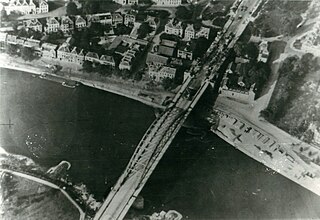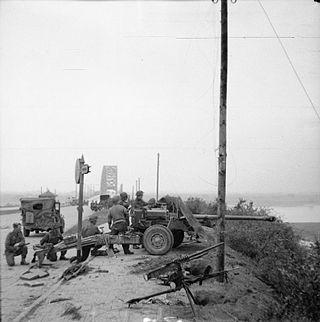
The Second Battle of El Alamein was a battle of the Second World War that took place near the Egyptian railway halt of El Alamein. The First Battle of El Alamein and the Battle of Alam el Halfa had prevented the Axis from advancing further into Egypt.

Operation Market Garden was an Allied military operation during the Second World War fought in the German-occupied Netherlands from 17 to 25 September 1944. Its objective was to create a 64 mi (103 km) salient into German territory with a bridgehead over the Nederrijn, creating an Allied invasion route into northern Germany. This was to be achieved by two sub-operations: seizing nine bridges with combined US and British airborne forces ("Market") followed by British land forces swiftly following over the bridges ("Garden").

The Battle of Arnhem was a battle of the Second World War at the vanguard of the Allied Operation Market Garden. It was fought in and around the Dutch city of Arnhem, the town of Oosterbeek, the villages Wolfheze and Driel and the vicinity from 17 to 26 September 1944. The Allies were poised to enter the Netherlands after sweeping through France and Belgium in the summer of 1944, after the Battle of Normandy. Operation Market Garden was proposed by Field Marshal Sir Bernard Montgomery, who favoured a single push northwards over the branches of the Lower Rhine River, allowing the British Second Army to bypass the Siegfried Line and attack the Ruhr. US Airborne troops were dropped in the Netherlands to secure bridges and towns along the line of the Allied advance. Farthest north, the British 1st Airborne Division landed at Arnhem to capture bridges across the Nederrijn, supported by men of the Glider Pilot Regiment and the 1st Polish Parachute Brigade. The British XXX Corps were expected to reach the British airborne forces in two to three days.

I Corps was an army corps in existence as an active formation in the British Army for most of the 80 years from its creation in the First World War until the end of the Cold War, longer than any other corps. It had a short-lived precursor during the Waterloo Campaign. It served as the operational component of the British Army of the Rhine during the Cold War, and was tasked with defending West Germany.

The 21st Army Group was a British headquarters formation formed during the Second World War. It controlled two field armies and other supporting units, consisting primarily of the British Second Army and the First Canadian Army. Established in London during July 1943, under the command of Supreme Headquarters Allied Expeditionary Force (SHAEF), it was assigned to Operation Overlord, the Western Allied invasion of Europe, and was an important Allied force in the European Theatre. At various times during its existence, the 21st Army Group had additional British, Canadian, American and Polish field armies or corps attached to it. The 21st Army Group operated in Northern France, Luxembourg, Belgium, the Netherlands and Germany from June 1944 until August 1945, when it was renamed the British Army of the Rhine (BAOR).

The Guards Armoured Division was an armoured division of the British Army during the Second World War. The division was created in the United Kingdom on 17 June 1941 during the Second World War from elements of the Guards units, the Grenadier Guards, Coldstream Guards, Scots Guards, Irish Guards, Welsh Guards, and the Household Cavalry.

Lieutenant-General Sir Brian Gwynne Horrocks, was a British Army officer, chiefly remembered as the commander of XXX Corps in Operation Market Garden and other operations during the Second World War. He also served in the First World War and the Russian Civil War, was taken prisoner twice, and competed in the modern pentathlon at the 1924 Paris Olympics. Later he was a television presenter, wrote books on military history, and was Black Rod in the House of Lords for 14 years.
This is the complete order of battle of Allied and German forces involved during Operation Market Garden.

Operation Veritable was the northern part of an Allied pincer movement that took place between 8 February and 11 March 1945 during the final stages of the Second World War. The operation was conducted by Field Marshal Bernard Montgomery's Anglo-Canadian 21st Army Group, primarily consisting of the First Canadian Army under Lieutenant-General Harry Crerar and the British XXX Corps under Lieutenant-general Brian Horrocks.

Operation Bluecoat was a British offensive in the Battle of Normandy, from 30 July until 7 August 1944, during the Second World War. The geographical objectives of the attack, undertaken by VIII Corps and XXX Corps of the British Second Army, were to secure the road junction of Vire and the high ground of Mont Pinçon.

The Battle of the Mareth Line or the Battle of Mareth was an attack in the Second World War by the British Eighth Army in Tunisia, against the Mareth Line held by the Italo-German 1st Army. It was the first big operation by the Eighth Army since the Second Battle of El Alamein 4+1⁄2 months previously. On 19 March 1943, Operation Pugilist, the first British attack, established a bridgehead but a break-out attempt was defeated by Axis counter-attacks. Pugilist established an alternative route of attack and Operation Supercharge II, an outflanking manoeuvre via the Tebaga Gap was planned. Montgomery reinforced the flanking attack, which from 26 to 31 March, forced the 1st Army to retreat to Wadi Akarit, another 40 mi (64 km) back in Tunisia.

The 43rd (Wessex) Infantry Division was an infantry division of Britain's Territorial Army (TA). The division was first formed in 1908, as the Wessex Division. During the First World War, it was broken-up and never served as a complete formation. It was reformed in the TA in 1920, and then served in the campaign in North West Europe from June 1944 until May 1945, during the Second World War. The division suffered heavy casualties and gained an excellent reputation. After the Second World War, the division formed part of the postwar TA, and became the 43rd (Wessex) Division/District in 1961. It was finally disbanded in 1967.

The 22nd Armoured Brigade was an armoured brigade of the British Army that saw service during and after the Second World War. The brigade was formed on the outbreak of war on 3 September 1939 from Territorial Army (TA) armoured regiments. It saw a considerable amount of action during the war, beginning with the Western Desert Campaign where it was engaged in Operation Crusader and at the Battles of Gazala, Mersa Matruh, First Alamein and Alam el Halfa. It then joined the 7th Armoured Division for the Second Battle of El Alamein. It remained part of 7th Armoured for the rest of the war, including the campaigns in Tunisia, Italy and North West Europe. It continued in the postwar TA until 1956. The brigade's identity was re-established in the Regular Army between 1981 and 1993.

The 8th Armoured Brigade was an armoured brigade of the British Army formed in August 1941, during the Second World War and active until 1956. The brigade was formed by the renaming of 6th Cavalry Brigade, when the 1st Cavalry Division based in Palestine converted from a motorised formation to an armoured unit, becoming 10th Armoured Division.

The Second Battle of El Alamein was a battle of the Second World War that took place near the Egyptian railway halt of El Alamein. The First Battle of El Alamein and the Battle of Alam el Halfa had prevented the Axis from advancing further into Egypt.

Operation Perch was a British offensive of the Second World War which took place from 7 to 14 June 1944, during the early stages of the Battle of Normandy. The operation was intended to encircle and seize the German occupied city of Caen, which was a D-Day objective for the British 3rd Infantry Division in the early phases of Operation Overlord. Operation Perch was to begin immediately after the British beach landings with an advance to the south-east of Caen by XXX Corps. Three days after the invasion the city was still in German hands and the operation was amended. The operation was expanded to include I Corps for a pincer attack on Caen.

This is the order of battle for the Battle of Alam el Halfa, a World War II battle between the British Commonwealth and the Axis Powers of Germany and Italy in North Africa between 30 August and 5 September 1942. The forces were the Eighth Army and the Panzer Armee Afrika

The 1st Airlanding Light Regiment was an airborne forces unit of the British Army's Royal Artillery during the Second World War.

The Battle of the Nijmegen salient or the Defence of the Nijmegen bridgehead was a series of engagements that took place in the Netherlands during World War II between 30 September and 8 October 1944. The battle occurred in the aftermath of Operation Market Garden, a failed attempt by the Allies to cut off German forces in the Netherlands and end the war quickly.

The 179th Field Regiment was a unit of the Royal Artillery, formed by the British Army during World War II. First raised in 1940 as infantry of the Worcestershire Regiment, after serving in the garrison of Iceland it was converted to the field artillery role in 1942. It fought with 43rd (Wessex) Division in the campaign in North West Europe. It was disbanded after the war.





















